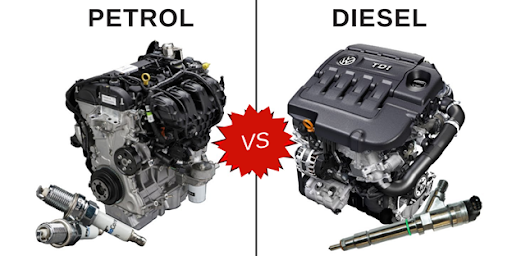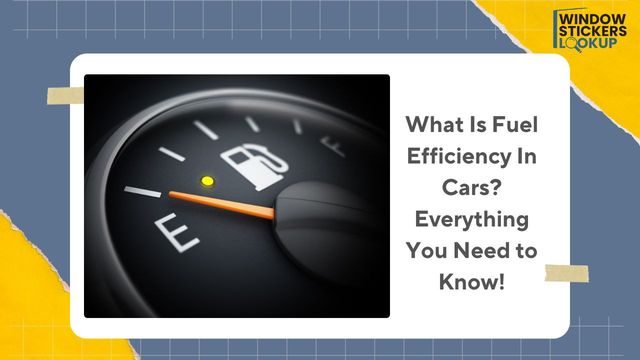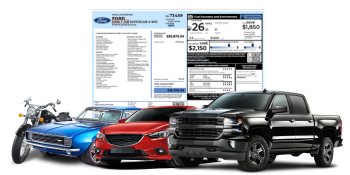With the unexpected rise and fall in gas prices, every car owner needs to prepare in advance to ensure their car’s fuel efficiency is a top concern.
When buying a car—new or used—the car’s fuel economy is usually one of the top factors to consider when cutting down on fuel running costs.
If you’re shopping for a used car that is not only safe to drive but also fuel efficient, you can easily compare the fuel efficiency and annual fuel cost of several models by looking up window stickers for vehicles to make an informed decision.
Carefully read on to know what fuel efficiency on a car is and how it’s calculated. We will also provide ways you can improve the fuel efficiency of your current car.
Fuel Efficiency, Fuel Economy, and MPG
While fuel economy describes the number of miles a car can drive per gallon of fuel, fuel efficiency is a descriptive term referring to how efficiently or economically a car can consume fuel. It can also be termed the fuel consumption rate.
On the other hand, MPG, or miles per gallon, is simply the distance (miles) that a car can travel per gallon of fuel. It’s used as the measurement unit of a car’s efficiency. The general rule is a car becomes more fuel-efficient with a higher MPG.
Don’t get confused. Now, let’s make it more straightforward.
The amount of fuel used (liters) per 100 kilometers results in fuel consumption. A lower outcome means a good fuel economy, while a high number means the car has poor fuel efficiency or economy.
However, if fuel efficiency refers to the distance traveled per unit of fuel used, you will want to have a high number because the higher the number, the more efficient the car is, and vice versa.
Read Also: What is the Cost of Car Ownership? The Cost of Owning a Car
How to Select the Best Fuel-Efficient Car
It’s important to know that different types of vehicles have differing fuel efficiency rates. For instance, a good fuel consumption for a small car is 5 – 6 liters per 100 km, but it’s between 8 – 9 liters for an SUV.
This means selecting the right car type is the first step in buying an excellent fuel-efficient car. Most cars come with both highway and city MPG ratings, and the combined MPG is usually the average of these two ratings.
To select the best fuel-efficient car when shopping for a car, you can do any of the following:
- Ask the seller or users of the exact model about the car’s fuel efficiency.
- Check the window sticker to verify the EPA fuel efficiency ratings.
- Contact the manufacturer or dealership to find the original label
- Use a vehicle window sticker lookup tool to get a replacement sticker.
Comparing Petrol vs. Diesel Engine for Fuel Efficiency

Diesel engines consume less fuel than petrol engines, and the latter are less fuel efficient. A car with a diesel engine can travel approximately 25% more kilometers per liter compared to a car with a petrol engine.
With technological advancements, many gasoline engines have improved fuel economy compared to more than a decade ago. However, in terms of energy output per use, diesel fuel yields more than petrol or gasoline engines.
How to Reduce the Fuel Consumption of Your Car?
Don’t forget that the EPA mileage rating is only an estimate based on a set of parameters and conditions. The actual mileage or rate of fuel consumption may vary based on several factors, including your driving habit, the car’s maintenance schedule, and weather conditions like extremely cold temperatures
Did you Know?
A temperature below 20 degrees Fahrenheit can significantly affect a car’s fuel economy, reducing it by 34% in some instances.
Here are some things you can do to enhance your car’s fuel efficiency.
Regularly maintain your engine—An issue with a car engine can badly affect fuel economy. For instance, a faulty oxygen sensor could lead to a 40% drop in MPG, an Energy and Environmental Analysis study says.
Avoid reckless driving and over speeding. Gas mileage tends to decrease very fast when you travel above 50 mph. Avoid unnecessary braking and rapid acceleration to save between 30% and 40% on fuel economy.
Avoid moving with heavy stuff. Excess weight on a car can negatively impact its fuel economy. A 2008 EPA study indicated that a car’s fuel economy is reduced by 1% for every 100 pounds added to its weight.
Ensure your tires gauge correctly. According to NHTSA, a one psi (pound per square inch) drop in the average tire pressure lowers gas mileage by around 0.2%.
Ensure your tires are always well inflated to improve fuel efficiency.
Avoid adding utilities that are not fuel-efficient friendly, including a roof-mounted cargo box, which can increase wind resistance and reduce fuel efficiency by almost 25%.
Frequently Asked Questions
What information does the window sticker provide?
The window sticker is a label containing details about a car’s original features and equipment and provides information on the NHTSA safety ratings and engine specifications like transmission, CO2 emissions, etc.
How can I maximize the fuel efficiency of my car?
To maximize the fuel efficiency, ensure you:
- Accelerate gently.
- Maintain a steady speed and avoid high speeds.
- Maintain engine well and ensure it’s functioning at optimal level.
Which cars have the best fuel economy or miles per gallon?
Some of the cars with the best fuel efficiency include:
1. Mitsubishi Mirage: 36/43/39 mpg city/highway/combined
2. Hyundai Elantra: 33/42/37 mpg
3. Honda Civic: 33/42/36 mpg
4. Kia Rio: 32/41/36 mpg
5. Toyota Corolla: 32/41/35 mpg
Is an electric vehicle better than a gasoline-engine car?
An electric car engine is better on torque. It’s also better when it comes to acceleration, as electric vehicles can accelerate from 0 to 60 miles per hour faster than gas-engine cars. However, the need to wait to charge an electric car and the high purchasing cost are some of the factors discouraging auto shoppers from switching to electric cars.









